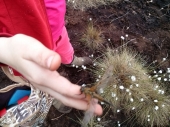On Nature’s Trail – a project for primary school children
Project participant – Kaunas Motiejus Valančius Primary School.
Creative agent – Eugenija Sutkutė, theatre pedagogue.
Creative practitioner – Andrejus Gaidamavičius, biological scientist.
Coordinating teacher – Rolanda Girskienė, primary school teacher.
Project participants – 23 third graders and 33 fourth graders.
Enquiry question
“On Nature’s Trail” was conceived as a creative learning project aimed at improving the literacy and linguistic expression of children in class 4c by combining different school subjects: dance, music, art, maths, Lithuanian, and nature.
The enquiry question chosen for the project – teaching children to think and write fluently by learning kinesthetically and working in a team. The third and fourth graders lacked the ability to concentrate, as well as listening and collaboration skills.
The specifics of this primary school’s class encouraged its participation in the project: a number of students lived in families receiving social welfare, some of them were traumatised by difficult family and life conditions, others barely spoke. The project also aimed to spark the children’s creativity and help them develop a more imaginative written language.
Nature was chosen to be the common literacy education theme. The project was meaningfully enriched through the natural literacy lessons prepared by the creative practitioner, biological scientist Andrejus Gaidamavičius. He presented environmental (water, plant) research to students and told them about finding animal tracks in natural environments.
Project activities
The method, which the practitioner called “nature therapy”, is especially useful in work with primary school children.
Through drawing, students learned to memorise the characteristics of different animal tracks. They were told about the places to look for them and got to know other nature-watching secrets. These nature-exploring methods were a sort of nature literacy basics, which were strengthened during field trips.
Tracking expedition. A tracking expedition was organised for all three primary school classes. The children wandered about the vast areas of a former swamp, looked for life that remained there and tried to find its tracks. They gathered a collection of plaster casts of animal tracks and learned about behaving considerately when outdoors.
Observing trees and bushes. Another task suggested by the practitioner – observing a chosen tree or bush throughout the project. Each student chose a tree or bush and, with the help of the scientist, learned its name. Students received a plant-watch sheet, where they had to note changes they see in the plant and its environment. This developed dutifulness, responsibility, attentiveness and a love for nature.
Chemical analysis of water and vegetables. Together with participating students, the creative practitioner carried out chemical tests of water and vegetables. At a few spots along the Nemunas river, water acidity, nitrate and nitrite amounts were analysed and the results were compared with drinking water. Children showed even more enthusiasm when testing their school canteen’s fruits and vegetables for nitrate levels.
Final presentation. At the end of the project, fourth graders presented their knowledge and skills at a community event. They did water and vegetable tests for the town’s inhabitants, told them about the dangers of nitrates. During the closing event at the school, class 4c was turned into a water and vegetable testing laboratory, animal tracks were analysed in the schoolyard and plaster casts of them were made.
Children were eager to join all activities where they had to explore the environment, without even feeling that they’re actually learning. They could carry out most project activities themselves, and activities taught children to look at their environment in a new and different way.
Impact on students
At the end of the project, the student’s ability to teach and learn was monitored. Results showed that primary school children significantly improved their ability to write fluent texts, and increasingly sought solutions to problems by asking a friend, a teacher, or a family member. Their imagination flourished: they didn’t just speak about what they did, they gave inventive names to things (e.g. not just tracks, but “beast’s indentations”).
The project’s impact on students is immense. Their worldview and vocabulary have widened, their imagination has developed, their communication skills have become better. The students started writing longer texts, their sentences have become fluent, they use more visual comparisons. These improvements in linguistic expression were verified by the results of the fourth grader’s standardised tests.
Project reflections
“When children have the opportunity to learn in a less restricting environment and have the freedom to go outdoors or change the space they’re in, they naturally act according to their nature: play, ask, explore. Then, even the shiest kids become more free and courageous. After a while, we couldn’t believe the number of questions they were asking. At first, we had to point out things that should be written down, but they soon started doing it themselves. Children with problematic behaviour also expressed themselves through creative learning: they poured out their energy by working with tools and objects. And kinesthetic learners have a hard time in education - even sitting in class for 45 minutes is hard for them to do. I’m happy that the children’s curiosity became purposeful not just during project activities, but in everyday life, too.” Coordinating teacher Rolanda Girskienė.
“Nature is where a child is not rammed into a corner. If he wants to, he can wander off from everyone else to delve deeper into personal exploration. And vice versa – it’s easier to communicate in nature, because there are common experiences. There’s a natural desire to share them. So linguistic expression, an inseparable part of communication skills, has more chances to develop in a natural environment than it does in a closed one, under artificial conditions.” Creative practitioner Andrejus Gaidamavičius.
|





